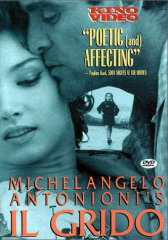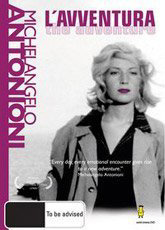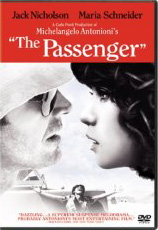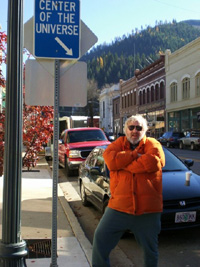|

Italian film director Michelangelo Antonioni directing
Daria Halprin and Mark Frechette in Zabriskie Point.
(Credit: WENN; courtesy of UPI Photo Service/NewsCom).
|
TRIBUTE TO MICHELANGELO ANTONIONI
Special Thoughts for
FILMS FOR TWO
by Alan Waldman
|
Italian writer-director Michelangelo Antonioni was one of the most radical and influential film figures of the post-war era. Writing and directing seminal works like BLOW-UP (1966), LA A’VVENTURA (1960), LA NOTTE (1961) and THE PASSENGER (1975), he significantly changed the pace, themes and visual aspects of movies, while showing that film could be an art form.
His themes included the emotional emptiness of modern life, man’s futile search to assert himself in a technological world and his frustrating inability to communicate with others.
In Antonioni’s films, actors are less important than the surrounding environment, which usually expresses alienation. He utilizes narrative vagueness to create mystery. And in all his films but BLOW-UP and IL GRIDO, interest centers on the female, with the male as a catalyst.
Over his 61-year career, Antonioni directed 38 films, wrote 30 and edited seven. He won a career Oscar, BLOW-UP was nominated for two more and 15 of his films won 35 major world awards and eight other nominations.
In 1983, the Venice Film Festival honored two of the all-time greatest movie directors, Antonioni and Sweden’s Ingmar Bergman, presenting them career Golden Lion awards. Strangely, 24 years later both died on the same day: July 30, 2007.
Michelangelo Antonioni was born on September 29, 1912, to a middle-class family in Ferrara, Italy. He studied economics and commerce at Bologna University, while he painted and wrote criticism for a local newspaper. In 1939 he went to Rome, studied directing at the School of Cinema. He worked for the journal Cinema, where he was part of the group of creative types who developed Italian Neo-realism.
During World War II, he worked with Roberto Rossellini on A PILOT RETURNS, assisted Marcel Carné on LES VISITEURS DU SOIR in France and made the first of several neo-realistic documentaries, GENTE DE PO, which dealt with the travails of poor fisherman on the Po River.
Antonioni later noted, “Documentaries had not focused on simple, poor people, because this was absolutely forbidden under Fascism.”
|

|
His first full-length feature film, CRONACA DI UN AMORE (STORY OF A LOVE AFFAIR, 1950), tells of a jealous, wealthy, older husband who hires a detective to spy on his attractive young wife, and, in the process, creates that affair (which had not previously existed)—with tragic results.
LE AMICHE (THE GIRLFRIENDS, 1955) begins and ends with the suicide attempts of an unhappy young woman and deals with the romantic escapades of her shallow friends. It featured the long takes and slow pacing that came to characterize almost all of Antonioni’s work.
IL GRIDO (THE OUTCRY, 1957) is a poignant
story of a poor factory worker's journey away from home,
through various liaisons and back again. Starring American
actor Steve Cochran, it was very compelling and had a very
distinctive look.
|
|

|
Antonioni’s 11 first documentaries and six features were all commercial failures, but L’AVVENTURA (THE ADVENTURE, 1960) changed both his career and the history of cinema. It won the Cannes Jury Prize “for a new movie language and the beauty of its images.” Yet Cannes audiences hooted, jeered and practically shouted down the film—in the presence of Antonioni, and his cast and crew—because they didn’t realize its revolutionary nature the way the jury did. Two years later, a poll of 100 critics by Sight & Sound magazine voted it the third-greatest film of all time, after CITIZEN KANE and BATTLESHIP
POTEMKIN.
L’AVVENTURA, in which Monica Vitti searches for a friend who has disappeared on a remote Mediterranean island and ends up in a relationship with the missing woman’s former lover, had stunning visuals, an unorthodox narrative style, languorous pacing and a strong air of mystery. It contained some shattering surprises, as when she is suddenly menaced by all the men in a town’s plaza, and when, near the end of the film, she discovers her lover inexplicably in the arms of a hooker on a hotel couch. As in all Antonioni’s best work, dramatic images help narrate the story. |
The trilogy of L’AVVENTURA, LA NOTTE (THE NIGHT, 1961) and L’ECLISSE (THE ECLIPSE, 1962) made Antonioni a famous, critically esteemed and popular filmmaker around the world.
Antonioni and producer Carlo Ponti signed a three-picture deal that allowed Michelangelo to direct three bigger-budget studio films, released by MGM.
The first, BLOW-UP (1966), was a box office hit and huge critical success. I loved it and still regard it as my favorite film of the 1960s. It follows a London photographer (well played by David Hemmings) who believes he may have accidentally captured a murder on film.
Widely regarded as the quintessential portrait of the swinging '60s London, BLOW-UP featured sex scenes that were shocking at the time, and it may have been the first movie to show characters smoking pot.
Unlike Antonioni’s previous and future work, BLOW-UP had a lively, jittery pace. It very effectively and imaginatively dealt with the question of reality versus illusion. One of the most memorable sequences in film history is the long section where Hemmings keeps blowing up a photo he took of Vanessa Redgrave and her lover in a park, until he can make out the killer, the gun and the dead body. The film ends with another unforgettable sequence, where he watches a group of hippie revelers mime a game of tennis, and soon he sees and we hear the non-existent ball being struck by the invisible racquets.
BLOW-UP was declared “Best picture of the year” by publications including Saturday Review, Life, Newsweek, Time, New Republic, New Yorker and the Los Angeles Herald-Examiner.
It was followed by the critical and box office flop ZABRISKIE POINT (1970), an existential rumination set in the Death Valley and starring two untalented amateurs: a 20-year-old Boston carpenter and a 19-year-old San Francisco coed. It lost a lot of money and provoked a bit of scandal.
|

|
The Italian director bounced back in 1975 with THE PASSENGER (PROFESSIONE: REPORTER), starring Jack Nicholson and sexy European star Maria Schneider (fresh from her success in the controversial Bertolucci opus LAST TANGO IN PARIS). In it, a jaded journalist decides to assume the identity of a man who died in the adjoining hotel room in the African desert, not realizing that he was an arms smuggler who is being pursued by killers.
It ends with probably the most memorable Antonioni shot ever: an astonishing 10-minute tracking shot that starts in a Spanish hotel room, goes towards the barred windows to view the plaza outside, passes between the bars to go outside, slowly turns, sees the killer entering the hotel and then shows Nicholson’s wife, girlfriend and the police finding his murdered body in the hotel room where the shot began. The DVD commentary reveals the secret of how this seemingly impossible shot was pulled off. Antonioni literally had the hotel constructed so that it could be split in half during the shot, with the camera seeming to move between the window bars. The film also features disturbing documentary footage of an actual firing squad execution in Africa. Though paced very slowly, THE PASSENGER is a very gripping movie. |
Antonioni also made movies in China and Germany, with the latter, IL MISTERO DI OBERWALD (MYSTERY OF THE OBERWALD, 1980), being an experiment in the electronic treatment of color, shot on video and then transferred to film.
Despite being largely incapacitated by a stroke in 1983, Antonioni continued directing films. In 1994, barely able to speak and appearing very frail, he directed John Malkovich, Jeremy Irons, Irene Jacob and Fanny Ardant in AL DI LA DELLE NUVOLE (BEYOND THE CLOUDS), frequently communicating with cast and crew by notepad.
In 1996, he was presented the Lifetime Achievement Academy Award by his friend Jack Nicholson. Months later, the Oscar was stolen by burglars and had to be replaced.
America’s greatest director, Martin Scorsese, wrote that L’AVVENTURA “gave me one of the most profound shocks I've ever had at the movies. It changed my perception of cinema and the world around me and made both seem limitless.” He added that Antonioni’s screen images “continue to haunt me, inspire me and expand my sense of what it is to be alive in the world.”
Movie critic Shawn Levy, in my local Portland Oregonian, wrote:
“The aesthetic rigor of Bergman and Antonioni films is entirely at odds with the pap that constitutes most American movies. But our notion that there are greater possibilities for cinema—personal expression, intellectual and emotional inquiry, and the creation of art in the way we think about the word when talking about opera, painting, theatre and literature—is crucially based on the appearance of films by these two men (along with a handful of others) on American screens from the mid ‘50 to the mid ‘70s.”
Film historian David Bordwell has written, “More than any other director, Antonioni encouraged filmmakers to explore elliptical and open-ended narrative. In Antonioni's work we must regard his images at length; he forces our full attention by continuing the shot long after others would cut away.”
Many Antonioni characters suffer from ennui, and their lives tend to be empty, aside from the gratification of pleasure or the pursuit of material wealth. Bordwell stated: “Vacations, parties and artistic pursuits are vain efforts to conceal the characters' lack of purpose and emotion. Sexuality is reduced to casual seduction, enterprise to the pursuit of wealth at any cost.”
In a speech about L’AVVENTURA at Cannes, Antonioni declared that in the modern age of reason and science, mankind still lives by “a rigid and stereotyped morality which all of us recognize as such and yet sustain out of cowardice and sheer laziness. My films explore the paradox that we have examined those moral attitudes very carefully and we have dissected them and analyzed them to the point of exhaustion, but we have not been capable of finding new ones.”
Antonioni’s films are aesthetically complex and often have elusive meanings. Australian film scholar James Brown states, “They are ambiguous works that pose difficult questions and resist simple conclusions. Classical narrative causalities are dissolved in favor of expressive abstraction, which leads to the creation of a stasis, occupied by vague feelings, moods and ideas. The spectator is compelled to respond imaginatively and independent of the film.”
Antonioni and Bergman have both admitted that they are very instinctual filmmakers. “When I am shooting a film I never think of how I want to shoot something; I simply shoot it,” Antonioni has confessed. “My technique, which differs from film to film, is wholly instinctive and never based on prior considerations.
“Reality changes so rapidly that if one theme is not dealt with, another presents itself. Allowing one's attention to be attracted by each little thing has become a vice of the imagination. All one has to do is to keep one's eyes open: everything becomes full of meaning; everything cries out to be interpreted, reproduced. Thus, there is no one particular film that I would like to make; there is one for every single theme I perceive. And I am excited by these themes, day and night. However, opportunity and other practical considerations limit and direct the choice.”
In defense of the deliberate way his films are paced, Antonioni has explained, “If a film is to take account of reality, it must also consider the rhythm of this reality; otherwise we produce something false. At certain times, life has different rhythms. At times it is dynamic, at other time static. So why should we avoid the static moments to concern ourselves only with the dynamic ones?”
Throughout his long career—but especially from the 1950s through the 1970s—Antonioni had a profound impact on cinema and continued to experiment with theme and form in radical, surprising and ultimately enlightening ways. For the intelligent moviegoer, each new Antonioni work was an event not to be missed, because he never stood still long enough to get stale.
In preparation for this article, I just watched seven Antonioni films. All were different. All showed massive talent and imagination. All were uniquely the creation of a special consciousness. And all were well worth my time.
ALAN WALDMAN’S FAVORITE ANTONIONI FILMS:
1. Blow-Up (1966)
2. The Passenger (1975)
3. L’Avventura (1960)
4. L’Amiche (1955)
5. Il Grido (1957) |
©Alan Waldman, October 31, 2007
|

|
Oregon gardener, fruit picker and gopher tormenter Alan Waldman has published more than 2000 magazine articles, won numerous awards and never been arrested for impersonating a clergyman. According to the latest figures, he is the oldest Jew in Oregon who has never owned real estate. His admiring wife Sharon calls him “Sparky.” |
|
